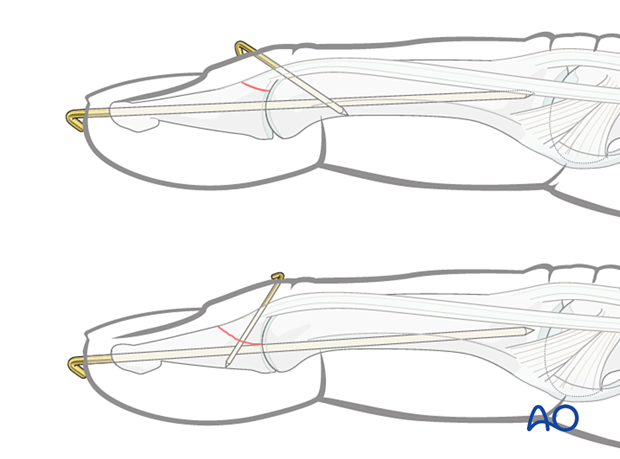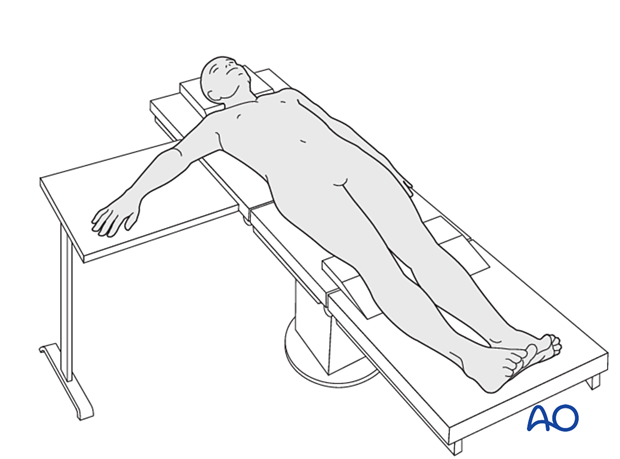Extensor block pinning or K-wire fixation (with joint transfixation)
1. General considerations
Introduction
Both extensor block pinning and K-wire fixation stabilize the dorsal fragment if the distal phalanx is still dislocated after closed reduction. Additionally, the DIP joint is transfixed with an axial K-wire.
Extensor block pinning can be used in case of smaller displaced dorsal fragments. It leaves the dorsal base, including the nail matrix, untouched.
If there is a large displaced dorsal fragment (>50% of the articular surface), the fragment can be fixed with a K-wire.

Operative treatment: caveat
Indications for surgical intervention are:
- Open fractures
- Palmar subluxation of the DIP joint

Surgical management of these fractures is difficult and has many potential complications. The soft tissues are only precariously vascularized, and the fragments are very small and prone to further comminution. Healing can often be slow.
Potential risks of percutaneous pinning
The commonest risk of percutaneous K-wire immobilization is infection.
Breakage of the K-wire at the level of the DIP joint can be avoided by using a wire of 1.6 or 1.8 mm diameter and counseling the patient to avoid stresses at the DIP joint. The fixation should be protected with a splint to reduce the risk of wire breakage.

2. Surgical anatomy
The base of the distal phalanx has a prominent dorsal crest at the insertion of the extensor tendon. The tendon is also adherent to the distal interphalangeal (DIP) joint capsule.
On the palmar surface is the insertion of the flexor digitorum profundus tendon. This is also adherent to the volar plate.
The flexor tendon occupies the whole width of the base of the distal phalanx. It is made up of two different fibers. The superficial fibers attach to the lateral aspects of the phalanx. The deep fibers run centrally and attach more distal in the palmar aspect of the phalanx.
The volar plate is very flexible, allowing hyperextension of the DIP joint and pulp-to-pulp pinch.
The vascularity of the extensor tendons is more precarious than that of the flexor tendons. This prolongs extensor tendon healing time.

Note the crisscross alignment of the fibers within the conjoint extensor tendons and also within the triangular ligament.


3. Patient preparation
This procedure is usually performed with the patient in a supine position with the arm on a radiolucent side table.

4. Marking K-wire track for joint transfixation
To avoid unnecessary radiation from image intensification, mark the planned track of the axial K-wire on the distal phalanx in both the AP and the lateral aspects.

5. Extension block pinning
Insertion of K-wire
Determine the precise location of the DIP joint with an image intensifier.
Use a drill guide or a 16G hypodermic needle to insert a 1.4 mm K-wire at an angle of approximately 45° through the terminal extensor tendon into the head of the middle phalanx. Engage the far cortex.
This K-wire serves as the extension block.

This intraoperative view shows the extension block K-wire in place and the dorsal fragment reduced.
The K-wire prevents the dislocation of the dorsal fragment.

Reduction
Insert an axial K-wire through the tip of the distal phalanx up to the DIP.

Carefully reduce the fracture by extending the DIP joint and shifting the distal fragment.
The axial K-wire may be used as a reduction tool.
Confirm DIP joint reduction with an image intensifier in the lateral view.

Joint transfixation
Advance the tip of the axial K-wire across the DIP joint into the base of the middle phalanx. Be careful not to penetrate the PIP joint.

6. Fracture fixation with a K-wire
Insertion of fixation K-wire
Use image intensification to determine the precise location of the DIP joint and the avulsed fragment.
Insert a 1.2 mm K-wire into the avulsed fragment.

Reduction
Insert a second K-wire through the tip of the distal phalanx up to the DIP.

Use the axial K-wire as a reduction tool to extend the DIP joint and reduce the fracture.

K-wire fixation
Advance the first K-wire into the main fragment, fixing the fracture. Engage the far cortex.

Joint transfixation
Advance the tip of the axial K-wire across the DIP joint into the base of the middle phalanx. Be careful not to penetrate the PIP joint.

7. Cutting the K-wires
Cut the K-wire so that it protrudes through the skin. Bend its end to form an L-configuration to prevent catching on clothing, etc. The tip of the bent wire can be rotated towards the ulnar side to avoid interfering with pinch grip, which involves the radial side of the pulp.
Leaving the K-wire to protrude through the skin in this way has the advantage of its being easy to remove. The disadvantages are patient discomfort and risk of pin-track infection.
The other K-wire is cut and bent in the same fashion.
Make sure that the bent ends do not irritate or compress the skin.

8. Immobilization
The fixation should be protected with a splint, leaving the PIP joint mobile, to reduce the risk of wire breakage.

9. Aftercare
Postoperative phases
The aftercare can be divided into four phases of healing:
- Inflammatory phase (week 1–3)
- Early repair phase (week 4–6)
- Late repair and early tissue remodeling phase (week 7–12)
- Remodeling and reintegration phase (week 13 onwards)
Full details on each phase can be found here.
Management of swelling
The arm should be actively elevated to help reduce any swelling.
Mobilization
Aftertreatment depends on the size of the fragment, the bone quality, and the stability gained by the fixation.
Hand therapy is recommended to prevent soft-tissue atrophy and joint contracture (typically extension of MCP joint and flexion of PIP joint), which leads to a poor outcome, and subsequent treatment is difficult.
Functional exercises of the nonimmobilized joints should be started immediately to keep uninjured joints mobile.
Active motion of the DIP joint is permitted after removal of the K-wire. Passive motion should be postponed for 8–10 weeks to avoid the risk of recurrent mallet deformity.

K-wire removal
Depending on the injury, the K-wires may be removed, usually after 4–6 weeks.
At this stage, X-rays should be taken to confirm healing.













